
Sea Surgeon's Dispensatory: 1 2 3 4 5 6 7 8 9 10 11 12 13 14 15 16 17 18 19 20 21 22 23 24 25 Next>>
The Sea Surgeon's Dispensatory, Page 20
Conserves and Sugars
Conserves and Sugars were made by combining herb parts (such as roots,
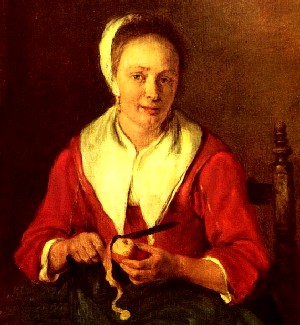
Artist: Gabriël Metsu - Peeling Apples (circa 1660-7)
stalks, barks, flowers, fruits and pulps) with sugar dissolved in water and boiling it to the desired consistency. Surgeon Thomas Brugis noted that the method for preparing a herb depended on the herb itself, "for some must be first cut, bruised and gently boiled, some neither, some one way onely; wherein the Artist by this caution, may shun erring."1
Brugis also explained that the medicinal virtue of the preserve was the same as the herb dissolved in it.2 As the name 'conserve' hints, sugars would protect the herb. (High sugar concentration causes bacteria to lose water by osmosis which prevents it from growing and destroying the herbs.3) How long a conserve (which includes preserves, jellies and jams) lasts depends on the amount of sugar used. Those made with equal quantities of sugar and herbs can last a year or more.4
Conserves and sugars would seem to be a natural choice for a sea surgeon, given their longer life. However, the Sea Surgeon's Dispensatory only contains 6 conserves.
1 Thomas Brugis, The Marrow of Physick, 1669, p. 86; 2 Brugis, p. 85; 3 Divya Sehgal, "How does sugar act as a preservative?", www.sciencefocus.com, gathered 7/6/15; 4 "How Long Does Jam/Jelly Last?", eatbydate.com, gathered 7/6/15
Conserva Anthos (Conserve of Rosemary)
Listed in: Woodall-Chest: Conser: Anthos.1
Category: Compound - Conserves and Sugars
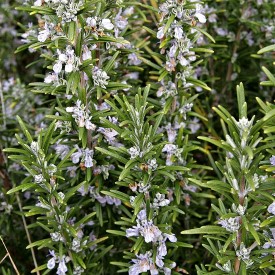
Rosemary Bush and Flowers
Humoral Property: hot and dry in the second degree2
Rx:"Of the finest flowers of Rosemary very small beaten {half pound} of the whitest Sugar {1.5 pounds} mix them well together, with a Box Pestle [the period definintion of a box pestle is not entirely clear, although one definition appears to be "pestle for soft substances"3] till they become a fine paste, which keep in a Gally-pot well luted [sealed]."4
Description: "Or Conserve of Anthos, or Rosemary flowers is of much use in phisicke [physic - medicine], because of the force it hath in comforting the braine and corroborating the sinewes, and it is given with good successe for the falling sicknesse [epilepsy], Apoplexie [unconsciousness caused by hemorrhage or stroke], Lithargie [lethargy], dead and shaking Palsie [Parkinson's disease], but it will not keepe long at Sea in hot Countries."5
1 John Woodall, the surgions mate, 1617, p. 81; 2 Thomas Brugis, The Marrow of Physick, 1669, p. 153; 3 "Bistortier", Larousse Encyclopedia, 1927, p. 113 - Bistortier is equated to 'box pestle in Alexander G. Collot's A New and improved standard French and English and English and French dictionary, , p. 113. Thanks to Jennie Gist for helping me figure this out. 4 Jean de Renou, A Medicinal Dispensatory, 1657, p. 539; 5 Woodall, p. 81
Conserva Barbaris (Conserve of Barberries)
Listed in: Woodall-Chest: Rob. Berberies1
Category: Compound - Conserves and Sugars
Humoral Property: cool (barberries)2, "doth refrigerate [cools]"3
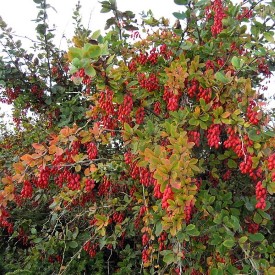
Photo: Arnstein Ronning - Barberry, Berberis Vulgaris
Rx: Nicholas Culpeper does not specifically say anything about Sugar of Barberry, rather he (somewhat reluctantly) follows the Royal College of Physicians of London's method of listing dozens of different plants that are made into sugars. As he explains, "with all these [various plants he listed] are Conserves made, with their treble proportion of white Sugar; yea note, that all of them must not be mixed alike, some of them must be cut, beaten and gently boiled, some neither cut, beaten nor boiled, and some admit but one of them, which every Artist in his Trade may find out by this Pemonition, and avoid [e]rror."4
Description: "Conserve of Barberies ...is astringent [draws together], it quencheth thirst, and the heate of the stomake, and bowels, it causeth appetite, removeth the waterish humor of choler, cureth the bloudy flix [bloody flux], the flux of the liver, the often gnawing and wringing of the guts caused by choler [yellow bile, one of the bodily humors], healeth the small pox, and resisteth drunkenesse."5
It is interesting that Woodall specifies this is a rob in the title and then calls it a conserve in his description. As physician Nicholas Culpeper explains, a "Rob or Sapa, is the Juyce of a Fruit, made thick by the heat either of the Sun, or the fire, that it is capable of being kept safe from putrefaction [rotting]."6 While the purpose of making a rob was the same as that as making a conserve, it lacked the added sugar and probably wouldn't have lasted as long. With that and Woodall's choice of the word 'conserve' in the description, he is almost certainly describing the conserve.
1 John Woodall, the surgions mate, 1617, p. 81; 2 Nicholas Culpeper, Pharmacopœia Londinesis, 1720, p. 42; 3 Woodall, p. 81; 4 Culpeper, p. 140; 5 Woodall, p. 81; 6 Culpeper, p. 133
Conserva Citronio (Conserve of Quinces)
Listed in: Woodall-Chest: Rob. Citonioruns1
Category: Compound - Conserves and Sugars
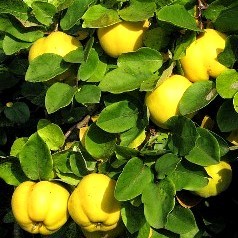
Photo: Dietrich Krieger - Quinces
Rx:"Of Quinces decorticated [having the outer skins removed], cut in five or six parts, purged from their membranes and seeds, {10 or 12}. Of Sugar the like weights: boyle them with a little water according to Art. ...after another manner: ...their succe [juice] is elicted [drawn out], cocted [heated], and strained, and twice as much sugar added to the colature [strained liquid], and cocted to the consistence of an Electuary; the succe is in equal weight mixed with sugar, and so the Conserve made of a red colour, grateful sapour [flavor], and eximious [distinguished] faculties." 2
Description: "Conserve of Quinces doth binde, comfort the stomake, is good for choler [referring to the bodily humor yellow bile], stoppeth all kinde of bloudy fluxes [bloody fluxes], and helpeth digestion."3
It is interesting that Woodall specifies this is a rob in the title and then calls it a conserve in his description. As physician Nicholas Culpeper explains, a "Rob or Sapa, is the Juyce of a Fruit, made thick by the heat either of the Sun, or the fire, that it is capable of being kept safe from putrefaction [rotting]."4 While the purpose of making a rob was the same as that as making a conserve, it lacked the added sugar and probably wouldn't have lasted as long. With that and Woodall's choice of the word 'conserve' in the description, he is almost certainly describing the conserve.
1 John Woodall, the surgions mate, 1617, p. 81; 2 Jean de Renou, A Medicinal Dispensatory, 1657, p. 543; 3 Woodall, p. 81; 4 Culpeper, p. 133
Conserva Lujulae (Conserve of Wood Sorrel)
Listed in: Woodall: Conser: Luiule1
Category: Compound - Conserves and Sugars
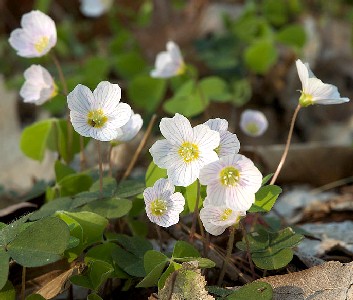
Photo: Jörg Hempel - Common Wood Sorrel (Oxalis Acetosella)
Humoral Property: moderately cold and dry (wood sorrel - allajula)2; cold and dry (wood sorrel)3; "refrigerateth [cool]"4
Rx: "Conservæ, Conserves
Of the leaves of Wood-sorrel;
Description: "Conserve of wood-sorrell doth recreate and comfort the heart, removeth putrede humors, refrigerateth [cools] and profitteth much in continuall, and contagious fevers, being very cordiall [good for the heart], but will perish in hot Countries: greate store of this herbe is found in Soldanie at the Cape of Good-hope as I am informed."5
1,2 John Woodall, the surgions mate, 1617, p. 81; 2 Nicholas Culpeper, Pharmacopœia Londinesis, 1720, p. 18, referring back to 'Acetosa, Sorrel' on p. 17; 3 John Pechey, The Compleat Herbal of Physical Plants, 1707, p. 220, referring back to Common Sorrel, p. 219; 4 Woodall, p. 81; 5 Henry Pemberton, Dispensatory of the Royal College of Physicians, 1747, p. 224-5; 6 Woodall, p. 81
Conserva Prunellorum (Conserve of Sloes)
Listed in: Woodall-Chest: Conser. Prunellorum1
Category: Compound - Conserves and Sugars
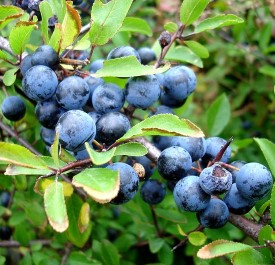
Sloes or Blackthorn Berries
Rx: "Scald the sloes in water to soften them, taking care, their skins are not broken; then take them out and express their pulp, which mix with thrice its weight of double refined sugar."2
Description: "Conserve of Sloes is of a comforting stipticke force [stops bleeding], very profitable to comfort the weake stomake oppressed with crudities [undercooked, cold and watery humours], good against all fluxes of the belly, and also good to heale all inflammations or excoriations [abrasions of the stomach] occasioned by the same, either taken on a knife in forme of a Bolus, or given in glisters [clysters - enemas]."3
1 John Woodall, the surgions mate, 1617, p. 82; 2 Henry Pemberton, Dispensatory of the Royal College of Physicians, 1747, p. 123-4; 3 Woodall, p. 82
Conserva Rosarum (Conserve of Red Roses)
Listed in: Woodall-Chest: Cons: Rosarum Rubrarum1, Moyle: Conserv. Rosarum rubr2, Tweedy: Cons. Rosar. rubr.3
Category: Compound - Conserves and SugarsHumoral Property: cold in the second degree, dry in the third (red roses)4; cold in the first degree, dry in the third (red roses)5; "cold and drie in the first degree" (red roses)6
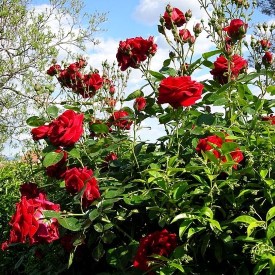
Photo: Wiki User Yellow Cat - Red Roses
Rx: "Take of Red Rose leaves the whites being cut off, and speedily dried in the Sun an ounce, white Sugar a pound, melt the Sugar in Rose water and juice of Roses, of each 2 ounces, which being consumed by degrees, put in the Rose Leaves in Powder, mix them, put it upon Marble, and make it into Lozenges according to art."7
Description: Woodall says that "Conserve of Red roses is good for the heart and head strengthening and comforting both, as also the bowels mitigating their heate, and stoppeth fluxions [flows], and is much the more profitable in any griefe if a few drops of oile of vitrioll be mixed herewith, but beware of too much. "8
Nicholas Culpeper agrees, adding considerably to Woodall's description. "As for the virtues of this, it strengthens weak stomachs, weak hearts, and weak brains, restores such as are in Consumptions, restores lost strength, stays fluxes [stops bleeding], easeth pains in the head, ears and eyes, helps spitting, vomiting and pissing of blood; it is a fine commodity for a man in a Consumption [tuberculosis] to carry about with him and eat now and then a bit"9.
1 John Woodall, the surgions mate, 1617, p. 80; 2 John Moyle, The Sea Chirurgeon, 1693, p. 31; 3 "158. John Tweedy's Bill for Medicines. November 8, 1743". Privateering and Piracy in the Colonial Period Illustrative Documents, John Franklin Jameson, ed., p. 458; 4 "Tacuin Roseter34.jpg", Roses From the Theatrum of Casanatense, wikimedia commons, gathered 6/1/15; 5 "File:Tacuin Rosebis33.jpg", Roses From the Tacuinum of Vienna, wikimedia commons, gathered 6/1/15; 6 Woodall, p. 116; 7 Nicholas Culpeper, Pharmacopœia Londinesis, 1720, p. 142; 8 Woodall, p. 80; 9 Culpeper, p. 142
Powders
Of powders, Physician Thomas Brugis says, "They are made of all dry things that may be powdered"1. You can't ask for anything more direct. He goes on to list the various uses for powders, noting that they can be used topically or internally and that some are simple, made from individual elements, while others are compound.
On the one hand, powders would be a convenient way to preserve medicines for long sea voyages. On the other, there would be a risk of their being spoiled in such a wet environment. There are only 14 compound powders included in the Sea Surgeon's Dispensatory, hardly a large representation in comparison to some of the other elements.
1 Thomas Brugis, The Marrow of Physick, 1669, p. 87
Hiera Picra Simple
Listed in: Woodall-Chest: Hiera Pigra1
Category: Compound - Powders
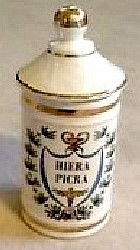
Hiera Picra Apothecary Jar
Rx: "Take of Cinnamon, Xysobalsamum, or wood of Aloes, the roots of Asarabacca, Spicknard, Mastich, Saffron, of each six drams; Aloes not washed twelve ounces and an half, clarified Honey 4 Pound and 3 ounces; mix them according to Art. Also you may keep the species by it self in your Shops."2
Description: Woodall uses Hiera Picra as part of the recipe for a purge for those who are severely constipated due to symptoms of scurvy. He warns that "if you intend not to have it purge much, leave out the species hiera pigra"3. He also says that it "doth bring forth the mollified [softened] feces or excrements"4.
Nicholas Culpeper adds an interesting use, explaining that it is an excellent remedy for "such idle fancies and Symptoms which the brain suffers thereby, whereby some think they see, others that they hear strange things especially when they are in bed, and between sleeping and waking"5.
1 John Woodall, the surgions mate, 1617, p. 240; 2 Nicholas Culpeper, Pharmacopœia Londinesis, 1720, p. 174; 3 Woodall, p. 188; 4 Woodall, p. 240-1; 5 Culpeper, p. 174
Pulvis Alchimistricus
Listed in: Woodall-Chest: Pul: alchimistricus.1
Category: Compound - Powders
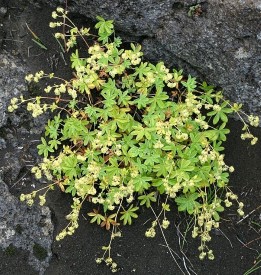
Photo: Wiki User geichhorn2000
Alchemilla Vulgaris - Lady's Mantle
Rx: Although this has a space in his medicine chest, Woodall does not talk about this powder anywhere in his book. I couldn't find it under this name in any of other pharmacopoeias or dispensatories, so how it is made is not entirely clear.
The name may refer to the herb alchemilla. In 1722 Pharmacopoeia Argentoratensis, one of the ingredients for a Defensative Plaster - Felicis Wurtzil is "Pulveris herbæ Alchymillæ uncias quatour" (Powder four ounces of tender Achemilla)"2.
Robert James mentions a alchemilla-based powder in his dispensatory: "...this Plant is of so powerful a conglutinating Quality, as to cure Ruptures of the Intestines, especially in Children; for which Purpose the dry Powder is exhibited in the Decoction, or the distill'd Water of the Plant."3
Description: "Alchimilla... Achimilla Vulgaris, C.B. Alchimilla Major Vulgaris, Park. Ladies Mantle.
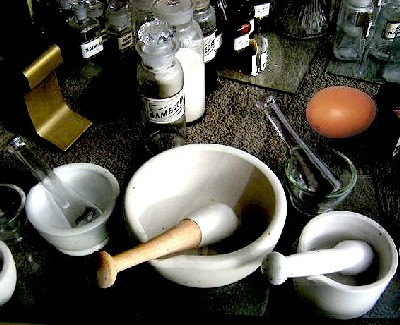
It grows in Meadows and pasture Grounds, flowers in May and June, and in July and August, and produces its Seeds. On account of its astringent [drawing together], viscid [adhesive], and glutinous [sticky] Juice it is class'd among vulnerary [wound healing] Plants, both applied externally with other Substances, and exhibited internally in vulnerary Potions, and Decoctions; for it inspissates [thickens] the thin Blood, and is for that reason highly beneficial in the Fluor Albus [white flow - leukorrhea], and immoderate menstrual Discharges. A Decoction of it is useful for washing Wounds, which may, also, be advantageously covered with a Cloth dipt in the same Decoction. ...From what has been said 'tis obvious, that this Plant is proper in consolidating Clyster for the Cure of Dysentereis."4
The Pharmacopoeia Argentoratensis refers to Alchymillæ as a vulnerary herb5, meaning it would be used to heal wounds.
1 John Woodall, the surgions mate, 1639, Diagram opp. page 26; 2 Johann F. Dulssecker, Pharmacopoeia Argentoratensis, 1725, p. 75; 3,4 Robert James, Pharmacopoeia Universalis, 1747, p. 214; 5 Dulssecker, p. 233;
Pulvis Arthriticus
Listed in: Woodall-Chest: Pulvis Archeticus Paracelsi1
Category: Compound - Powders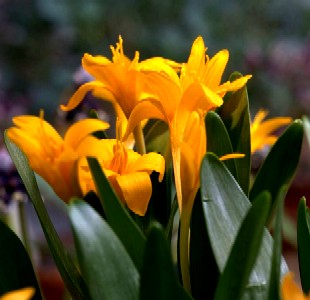
Photo: Gustav Svensson - Hermodactyl (Colchicum luteum)
Rx: "Hermodactyls [probably colchicum], turbith [Operculina turpethum], diagridium [scammony], sennæ, filings of man's skull, sugar, of each {1 ounce} powdered; mingle them, and keep them close in a glass."3
Description: "This is a Laxative powder, made only of foure vegetables and one Animale simple, with also the addition of Sugar, to give it the more gratefull taste, and the dose is to {1 dram} at the utmost, besides the sugar: I can speake of the pleasure and profit I have had by this mean purging powder, I say pleasure, for that it it is so pleasant and easie to bee taken, and profit to me many wayes, for it is to me my generall purging medicine, when I would purge downwards upon any repletion [overfilling] of the body, or generall cause of evacuation downewards, and I finde it indifferent in purging any offending humour, according to the commendations the Authour giveth of it, I can no more misse this plaine and harmlesse ready purge, then I can misse my saluatory: Oswaldus Grallius [16th century German alchemist and Paracelsian Oswald Croll] a most reverent late writer, hath set downe this onely purge, for the cure of the Podagar [podagra - gout], giving it this breefe commendation, it purgeth safely and gently all podagricall defluctions [deluxions of humors in a part, caused by gout]: and in truth whosoever shall have occasion of the use therof, will have cause to commend it, ...{1/2 dram} of this will doe as much with great facility... I use to give it to strong bodies in white wine, to weaker in Sacke [fortified white wines], but at sea it may be given for a need with faire water [clean, pure water], and some sirupe to helpe the taste thereof, which neverthelesse is not ungratefull of it selfe."4
1 John Woodall, the surgions mate, 1617, p. 92; 2 John Moyle, The Sea Chirurgeon, 1693, p. 35; 3 Thomas Brugis, The Marrow of Physick, 1669, p. 90; 4 Woodall, p. 92
Pulvis Benedictus (Blessed Laxative)
Listed in: Woodall-Chest: Benedicta Laxatina.1
Category: Compound - Powders
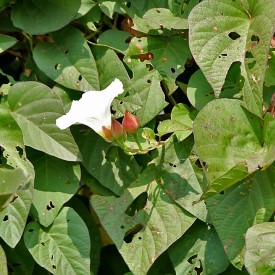
Photo: J. M. Garg
Turbith - Operculina Turpethum
Rx: " Take of choice Turbith [Operculina turpethum] ten drams, Diagridium [scammony], Bark of Spurge Roots prepared, Hermodactyls, red Roses, of each five drams, Cloves, Spicknard, Ginger, Saffron, long Pepper, Amomus [amomum - an India spice plant], or for want of it, Calamus Aromaticus, Cardmoms the less, the seeds of Smallage, Parsley, Fennel, Sparagus, Bruscus, Saxifrage, Gromwel, Caraway, Sal. Gem [Sal Gemmi - rock salt], Galanga, Mace of each a dram with their treble weight of clarified Honey; make 'em into an Electuary according to Art."2
Description: "Benedicta Laxatina, or the blessed Laxative, it doth open mightily obstructions, purgeth choler, fleame [yellow bile & phlegm, two of the bodily humors], & all clammy humours from the joynts, reines [kidneys] and bladder: and is tearmed Benedicta, because it benignely looseth the belly, The dose is {1 dram}."3
"It purgeth flegm chiefly from the joynts; also it purgeth the reins & bladder. I willingly omit the quantity of these Purges, because I would not have foolish women and dunces do themselves and others mischief. For it worketh too violently for their uses, and must be prudently ordered, if taken at all; for I fancy it not at all, but am of opinion it kills more than it cures."4
1 John Woodall, the surgions mate, 1617, p. 91; 2 Nicholas Culpeper, Pharmacopœia Londinesis, 1720, p. 168; 3 Woodall, p. 91; 4 Culpeper, p. 168
Pulvis Diagridium (Powdered Scammony)
Listed in: Moyle: Pulvis Diagridium1
Category: Compound - Powders
Photo: Eitan F. - Scammony (Convolvulus Scammonia)
Rx: "The Preparation of Scammony is in the following manner: Put the Powder of Scammony into a Quince made hollow, cover'd with Paste, and baked in an Oven, or roasted under Ashes; take out the Scammony, and being so prepar'd, 'tis called Diagridium."2
Description: "Scammony, in Latin Scammonium. The best comes from Antioch [Greece]; 'tis clear, splendid, melts easily, and breaks easily, is not very weighty; being touched with the Tongue it grows milky, when it is broken 'tis yellowish; but that which we have commonly is of an Ash-colour, and looks ill, because it is not the Liquor or Tear flowing from the Plant, but the Juice press'd out. It purges strongly Cholerick [yellow bile, one of the bodily humors], Watery and Sharp Humours from the remote Parts, and therefore is frequently used for such Purposes [treating gout would be an example of this]. The Dose is, from six Grains to a Scruple. But it is most commonly used mix'd with some other thing."3
1 John Moyle, The Sea Chirurgeon, 1693, p. 32; 2 John Pechey, The Compleat Herbal of Physical Plants, 1707, p. 330-1; 3 Pechey, p. 330
Pulvis é Myrrha Compositum (Compound Powder of Myrrh)
Listed in: Moyle: Pulvis Myrrhæ1, Tweedy: Myrrh. Pulv.2
Category: Compound - Powders
Powdered Myrrh
Rx: "Take of the dried Leaves of Rue, Dittany of Crete, Myrrh, of each an Ounce and a half; Asa Fœtida [gum of the root of asafoetida], Sagapenum, Russia Castor, Opoponax, of each an Ounce. Beat all together into a Powder."3
Description: "This is substituted for the Troschisci Myrrha, and is excellent for promoting the Uterine Discharges, and Explusion of the Fœtis."4
"This is a reform of the trochisci e myrrha, a composition contrived by Razi [9th-10th c. Persian physician Muhammad ibn Zakariyā Rāzī] against uterine obstructions. This powder may be taken from a scruple to a drachm or more, two or three times a day."5
This medicine is identified by several sources6 as being for treating uterine problems, which would be specific to women. Since there were rarely women on ships, it is curious that both John Moyle and John Tweedy included it in their chests. However, Moyle suggests its use in curing a wound after amputation, to cause exposed bone sticking out the end of the stump to exfoliate [shed the exposed surface]7 and for a similar purpose in large wounds with exposed bone.8
1 John Moyle, The Sea Chirurgeon, 1693, p. 32; 2 "158. John Tweedy's Bill for Medicines. November 8, 1743". Privateering and Piracy in the Colonial Period Illustrative Documents, John Franklin Jameson, ed., p. 460; 3,4 Robert James, Pharmacopoeia Universalis, 1747, p. 715; 5 John Quincy, Pharmacopoeia Officinalis & Extemporanea, 1782, p. 473; 6 For other examples, see The Edinburgh New Dispensatory, 1789, p. 560 & William Lews, The New Dispensatory, 1770, p. 552. Note, however, that all these sources read the same way, suggesting they are all from the same original source; 7 Moyle, p. 60; 8 Moyle, p. 62
Pulvis Euphorbium
Listed in: Moyle: Pulvis Euphorbium1
Category: Compound - Powders
Humoral Property: "hot and drie almost in the fourth degree"2
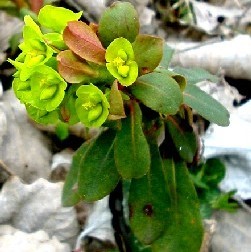
Euphorbia Wood Spurge
Rx: The period dispensatories and pharmacopoeias don't contain a recipe for powdered euphorbium. Since the euphorbium sold in England was in a gum form, the powdered version may have simply been the remnants after the gum had dried. This can't be stated with certainty, of course.
Description: "Euphorbii, Euphorbium. This is a Gum, or rather inspissated [thickened] Juice, of a pale yellow Colour, and concreted into Drops of different shapes. [Flemish physican Rembert] Dodonæus says it is gotten from a Plant; but [Pedanus] Dioscorides, that it comes from a Tree. ...the more curious among the Moderns have found it to proceed from a thick-leaved African Spurge. It is so extremely hot and penetrating, as to prove even Caustick [corrosive]: wherefore, altho' it is mention'd as a Purge in many Authors, against serous and viscous Humours, and its Dose assign'd from half a Scruple to a whole one; yet it is now never given inwardly, because its Violence tears off the necessary Mucus, or Covering of the Stomach and Bowels, and occasions Dysenteries. As a Sternutatory [medicine to cause sneezing], it is to be used very cautiously, and never taken alone; but mixed in a small quantity with some other Powder, proper to soften the Fibres, and guard them against the intolerable Heat of the Euphorbium. In pounding it [with a mortar and pestle] there may be much danger; because without great care so much will fly up the Nostrils, as to do mischief. This is of good use in Chirurgery, in cleansing very foul Ulcers, and exfoliating of carious [rotting] Bones."3
1 John Moyle, The Sea Chirurgeon, 1693, p. 32; 2 John Woodall, the surgions mate, 1617, p. 95; 3 John Quincy, Pharmacopoeia Officinalis & Extemporanea, 1719, p. 196
Pulvis ex Chelis Cancrorum Compositus (Gascoine/Gascon's Powder1)
Listed in: Moyle: Pulvis Gasconis2
Category: Compound - Powders
Humoral Property: hot & dry in the 3rd degree4; hot & dry in the 2nd or 3rd degree5; "hot in the first degree and drie in the third"6
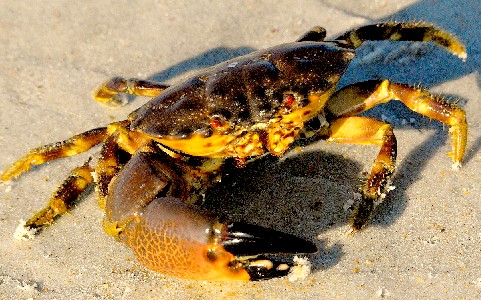
Photo: Andrea Westmoreland - Black Tipped Stone Crab Claw
Rx: "Take of Pearls prepared [powdered], Crabs eyes, red Coral, white Amber, Harts Horn, Oriental Bezoar, of each half an ounce; powder of the black tops of Crabs claws, the weight of them all; beat them into a powder, which may be made into balls with Jelly and the skin which our Vipers have cast off; warily dried and kept for use."3
Description: "This is that Powder they call Goscoigns powder, there are divers Receipts [recipes] of it, of which this is none of the worst, though the making of it up be Antick [bizarre], and exceeding difficult, if not impossible; but that it may be had to do a man good, when Adders skin cannot be gotten, you may make it up in a Jelly of Harts horn, into which put a little Saffron. Four or five or six grains is exceeding good in a Fever, to be taken in any Cordial [medicine for the heart]: for it chears the Heart and Vital Spirits exceedingly and makes them impregnable."4
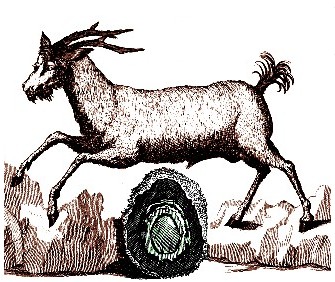
Goat and Bezoar Stone, From
The History of Druggs,
by Pierre Pomet, 3rd ed., p. 257
"This has the Repute amongst many of being a mighty Cordial; but such are deceived by their having observed in frequently to be prescribed by Physicians of the best Note, in almost all acute Cases. Its Alexipharmick [poison resistant] Quality can be supposed to arise from nothing in the Composition besides the Bezoar; but from many Experiments I have found, that there is no such Power in that Drug. The Virtue of the whole then is absorbent, which is common to it with all testaceous [brick red colored] Powders. ...Nor can it have an Diaphoretick [sweat-inducing] effect, unless, as the Logicians speak, by Accident... Such Persons therefore are great[ly] mistaken, who by perusing the Bills of Physicians, and finding this and such like Medicines frequently to occur, imagine themselves able to cure all acute Distempers by almost their help alone. There are indeed many Instances where the most Prudent must wait the Efforts of Nature, and see which way the principal Relief from Medicine is to be given; and in the mean while must do something to answer the Expectations of a Patient, and give a little present Ease; but to lay the sole Dependance on such languid Helps, when something of efficacy is indicated, is what can proceed from nothing but Ignorance or something worse."5
1 Michelle DiMeo and Joanna Warren, "The Countess of Kent’s Powder: A Seventeenth-Century 'Cure-all'", The Recipes Project, http://recipes.hypotheses.org, gathered 7/8/15; 2 John Moyle, The Sea Chirurgeon, 1693, p. 32; 3,4 Nicholas Culpeper, Pharmacopœia Londinesis, 1720, p. 143; 8 John Quincy, Pharmacopoeia Officinalis & Extemporanea, 1719, p. 432-3
Pulvis Ipecuanhæ
Listed in: Tweedy: Pulv. Ipecacuanh.1
Category: Compound - Powders
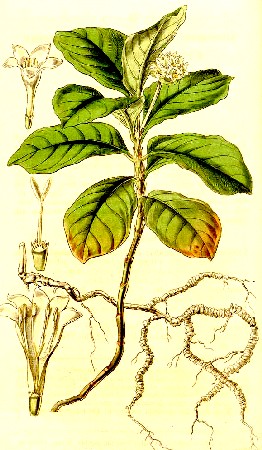
Ipecacuanha carapichea, From Curtiss
Botanical Magazine, Vol. 70 (1844)
Rx: "He [French apothecary Simon Boulduc] made a resinous Extract [of ipecacuanha] with Spirit of Wine, and then drew out the saline [salt] Particles with Rain-water [all plants were believed to contain fixed salts which could be extracted from them by natural means3], and found by Experience that its Violence, as in most other Purgatives, was owing to its Resin."4
Description: "...the saline Extract, [is] diuretic, purg'd gently, with little or no Nausea, and in short was possessed of the specific Quality of the Root in curing. The Root is given from fifteen Grains to half a Dram, and we ought never to exceed a Dram. It never fatigues the Stomach, and is the best Seccedaneum [substitute] for emetic Tartar. It is the best Specific in Dysenteries hitherto known, acting in such Cases, not only as an emetic, but also deterging [cleansing] Ulcers in the Intestines by a Mucilage [viscous secretion] contain'd in it, like that of Marshmallows [marsh-mallow - Althaea officinalis], by which it in some Measure supplies the villous Coat of the Intestines, when corroded and destroy'd by Disease. It also powerfully agitates and evacuates the Gland of these Parts. ...This Root has at once and emplastic [adhesive] and detersive [cleansing] Quality, and tho' it does appear sensibly acrid [pungent], yet it produces, in those who powder it, an Oppression of the Thorax, Difficulty of Breathing, and Spitting of Blood. It is likewise of sensive [sensitive] to the Eyes, increases the Discharge of the lachrymal Glands, and when the Tears do not find a ready Vent, produces a Swelling of the Eyes."5
1 "158. John Tweedy's Bill for Medicines. November 8, 1743". Privateering and Piracy in the Colonial Period Illustrative Documents, John Franklin Jameson, ed., p. 459; 3 Ephraim Chambers, "Salt", Cyclopaedia, Vol. 2, 1728, not paginated; 4,5 Robert James, Pharmacopoeia Universalis, 1747, p. 345
Pulvis Jalapii (Powdered Jalap)
Listed in: Moyle: Pulvis jalapi1, Tweedy: Pulv. Jalap.2
Category: Compound - Powders
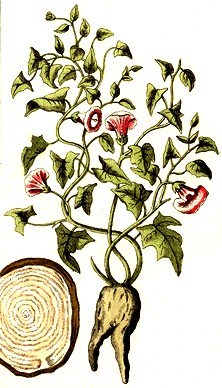
Ipomoea Purga, From Convolvulus
Mechoacanna by Johannes Zorn (1796)
Rx: French apothecary Simon Boulduc's "Experiments were made by Extraction [of powdered Jalap] with Spirit of Wine, and common Water: twelve ounces of the Root yielded, with Spirit of Wine, two Ounces of a resinous Extract well dry'd; the remainder being likewise well dry'd, weigh'd nine Ounces and six Drams. Out of this he got four Ounces of a very solid and pure Extract."3
Description: "Jalapii, Jalap. This is the Root of a Plant not unlike our Bryony [bryonia], and is therefore by some call'd Bryonia Peruviana; for it is brought to us chiefly from Peru and New-Spain [Central America & southern North America mostly]. ...That which breaks blackest, most brittle, sound and shining within side, is best; by reason the resinous Parts, which give in those Properties, are suppos'd to contain its medicinal Virtues. ...He [French apothecary Simon Boulduc] says it is one of the best Catharticks [purging medicines] we have. He has found it so by Experience, and wonders that it is so little us'd at present: for as it is so gentle that it stands in need of no Corrector [additional medicine used to dampen the violence of its purging effect]... [The powder] was very Diuretick, as he experienced in many Hydropsical Cases [edemas]: that the Residue which yet contain'd a little of what was resinous, purg'd reasonably, but with Gripings [pains in the stomach and intestines] ...it's griping Quality may be commonly corrected by fix'd Salts, or Loaf-Sugar."4
1 John Moyle, The Sea Chirurgeon, 1693, p. 32; 2 "158. John Tweedy's Bill for Medicines. November 8, 1743". Privateering and Piracy in the Colonial Period Illustrative Documents, John Franklin Jameson, ed., p. 459; 3 John Quincy, Pharmacopoeia Officinalis & Extemporanea, 1719, p. 193; 4 Quincy, 192-4
Pulvis Resina Jalapii
Listed in: Moyle: Pulvis Razina Jalapi1

Ipomoea Purga, From Convolvulus
Mechoacanna by Johannes Zorn (1796)
Category: Compound - Powders
Rx: "Take of select (that is what is blackest, most heavy and sound) Jalap powder'd {1 pound} put to it of rectify'd Spirit of Wine {4 pounds} invert a Bolt-head [a round container with a long neck], and lute it [put clay around it; set it upon warm Sand [created by a sand furnace that heats a container of sand in which the vessels are set] three of four Days, and shake it every Day two or three times: when the Spirit is well ting'd, decant it carefully thro a Hair Sieve into a Cucubit [glass bowl]; set it in a gentle Heat of Sand [the sand furnace], and draw off the Spirit of Wine to one Pint, which may be return'd upon the Jalap to make a second Extraction: decant the Spirit as formerly; lute on its Head and Receiver [the clay is to seal the connection point], and distil as before. Let all cool, and in the Cucurbit there will be a Resin in the form of Turpentine; which wash in three or four Waters, and in a gentle Heat dry it, till it will beat into Powder."2
Description: Apothecary John Quincy says it works the same as the root of jalap. (a purging medicines that is very diuretic, used in edemas3). Howerver, he notes that "it works tougher, because of all such Substances stick to and hang upon Coats of the Stomach and Intestines, so as to be the Authors of a great deal of Pain and Uneasiness; and for this reason, this is corrected [the purging effect is reduced] with Sugar, Cream of Tartar, or such like things... Its Dose from {3 grains to a scruple}."8
1 John Moyle, The Sea Chirurgeon, 1693, p. 32; 2 John Quincy, Pharmacopoeia Officinalis & Extemporanea, 1719, p. 303; 3 See Quincy, p. 183-4; 4 Quincy, p. 184
Pulvis Restringens Major
Listed in: Woodall-Chest: Pul. Restringens major.1, Moyle: Pulvis Restringents2
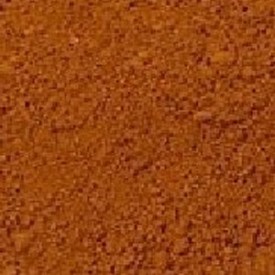
Armenian Bole
Category: Compound - Powders
Rx: In his commentary on fractures, Woodall gives the prescription for a medicine to stop bleeding that is probably the powdered Restringens Major. "Bole [clay] {3 ounces}, Aluminis. [alum], Thus [Frankincense], ana. [mixed] {half ounce, Radix Consolida [comfrey roots] in powder {2 drams} [and] Lepis Abulosus [a German patent medicine also called Lapis Zabulousus] { half ounce}. This all made into fine powder"3.
Description: Powdered restringent major is Latin for 'powder to stop major bleeding.' Although his recipe is in fractures, Woodall does not discuss the uses of Pulvis Restringens Major anywhere in particular, probably because it would have been apparent to his audience.4
Sea surgone John Moyle includes two restrictive medicines in his chest. The first is "Restrictiva Maxima", which is an ointment, appearing elsewhere in this article. The second is Pulvis Restringents, which refers to a powder to stop bleeding. Although it may be of a different composition than Woodall's powdered restrictive. Moyle doesn't provide any further information, however, so it is impossible to list the ingredients. So it has been listed here.
Moyle does recommend the use of 'restingent pouder' in "the Cure of a great Wound in a Musculous Part, with loss of substance."5 He also mentions their use by some surgeons for curing a "violent Bleeding at Nose", although he prefers revulsion (bleeding from a distant body part to divert the flow of blood).6
1 John Woodall, the surgions mate, 1639, Diagram opp. page 26; 2 John Moyle, The Sea Chirurgeon, 1693, p. 32; 3,4 Woodall, p. 162; 5 Moyle, p. 63; 6 Moyle, p. 241
Pulvis Restringus Minus
Listed in: Woodall-Chest: Powdered restring. minus1

Armenian Bole
Category: Compound - Powders
Rx: This does not appear in most medicinal books from the period. It may have been a concoction specific to Woodall. Although he does not specifically discuss this styptic in his section detailing medicines, he elsewhere lists the ingredients for an "ordinary" restrictive/restringent that is very likely this medicine or similar to it:
"It will doe well if it be in the ship to make also a restrictive ready, namely of Bole with water and vinegar, if an egge be not to be had; but an egge in the restrictive will make it the better."2
Although this is not a powder (pulvis is Latin for powdered), Woodall elsewhere includes some of the same ingredients in preparing a powder to stop major bleeding, excluding the egg and/or water which are added to the powder just before application.
Description: 'Powdered restringent minor' refers to stopping minor bleeding.
1 John Woodall, the surgions mate, 1639, Diagram opp. page 26; 2 Woodall, p. 5
Tramatic Powder
Listed in: Moyle-Concoction: Tramatic Powder1
Category: Compound - Powders
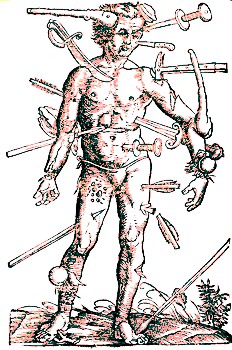
A Variety of Traumatic Injuries - Wound Man
From Feldtbuch der Wundartzney,
By Hans von Gersdorff (1517)
Rx: "Pulv. Terra sigillata [powdered sealed earth], Lap. Hyber. [powdered Irish slate] Sang Dracon. [powdered dragon's blood resin] Mummia [powdered mummy], Sperm. Cœti, {of each 1 dram}, Pulv. Rhubarb [powdered rhubarb] {1/2 dram}. misce f. Pulv. [make into a powder]"2
Description: Moyle explains that traumatic medicines were "for inward Bruises, and penetrating Wounds of the Body" and directed that the sea surgeon must have such medicines.3
"Sometimes this Pouder is taken in Posset drink, or warm Beer [posset drinks were cream-based, often with sugars, ales or wines and other flavor enhancers like cinnamon or ginger and rose-water. They were believed to be good for curing the ill.]; and other times Bolus wayes [a bolus is a single, often large dose of medicine] in Venice Tracle, but which ever way you give it the dose is two drachms at a time.
Generally at Sea Spruce Beer alone serves [cream would be hard to come by]; or else Lap. Hyber. & Sperm Cœti in a Bolus; but the Patient is alwayes to be caused to sweat, when you give these Traumaticks, and then they conduce wonderfully to the Cure."4
1,2,3,4 John Moyle, The Sea Chirurgeon, 1693, p. 19
Electuaries
Electuaries are pastes made with medicinal simples mixed with syrup or honey. John Quincy groups syrups, confections and honeys as electuaries.1 He notes that only substances "conveniently drawn out by Decoction [heating or boiling] in an Aqueous Menstruum [liquid solvent], or the express'd Juices of Plants, Fruits, &c. for any thing of a Volatile or Spiritous Nature"2. He notes that substances that ferment are not "fit for this Form, because they will run into new Coalescencies [blended substances], and
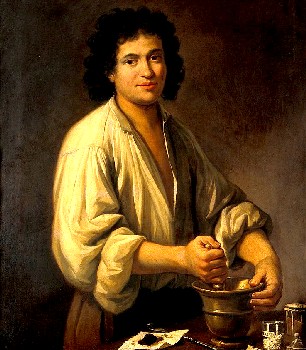
Apothecary Using Brass Mortar & Pestle To Mix
Medicines, From the Wellcome Collection (18th c.)
destroy the Consistence of the Medicine by some parts being too thick and ropy, and others too thin: the Juices therefore of Fruits, for this reason, soonest decay in Syrups."3
Quincy explains that dried herbs are the best for making the medicinal components into an electuary. In addition to the problem of decay in juices, he notes that they "leave some Portion [of the plant substance] behind; the most probably which is the best, as the thin watry Parts run off first"4. As a result, dried plants "will be both finer and keep longer, as well as be stronger of the Ingredient."5
In The English Physitian, Nicholas Culpeper gives an outline for making Electuaries. He advises the reader to "keep alwaies Herbs, Roots, Seeds, Flowers, &c. ready dried in your house, so that you may be in readiness to beat them into powder when you need them."6 He also suggests that it is better for them to be kept "whole than beaten: for being beaten they are the more subject to lose their strength, because the Air soon penetrates them."7
Culpeper suggests powdering the dried plant preparing an electuary, and filtering them "through a fine Tiffany Searce"8. 'Tiffany' is a "fine, delicate linen" which would be used to line the searce [sieve].9 Culpeper mixes the powder with clarified honey, combining it in a mortar. He advises the reader "take this for a truth, You can not mix them too much."10 It is then heated to remove impurities and the result is kept in a pot. "The usual Dose of Cordial Electuaries, is from half a dram to two drams; of purging Electuaries, from half an ounce to an ounce."11
1,2,3 John Quincy, Pharmacopoeia Officinalis & Extemporanea, 1719, p. 371; 4,5 Quincy, p. 372; 6 Nicholas Culpeper, Pharmacopœia Londinesis, 1720, p. 278; 7 Culpeper, p. 278-9; 8 Culpeper, p. 279; 9 "Tailoring Vocabulary - Lawn", The Renaissance Tailor Website, gathered 7/14/15; 10,11 Culpeper, p. 279;
Aurea Alexandrina Nicolai
Listed in: Woodall: Aurea Alexandrina1
Category: Compound - Electuaries
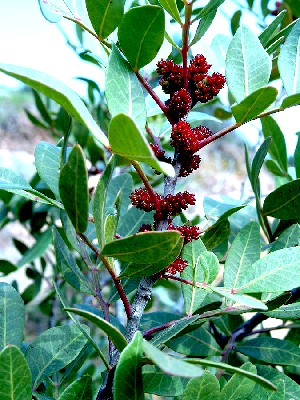
Pistacia Lentiscus
Rx: "Asari [Manchurian wild ginger], Carpobalsami [spice from Pistacia lentiscus tree] ana dramnas duas semis, {mix two and a half drams}, Caryophyllorum [Cloves], Opii Thebaici [Opium of Thebes], Myrrhæ [Myrrh], Cyperi rotundi [Cyperus rotundus - nut grass] ana drachm. Duas {mix 2 drams}, Sem. Hyoscyami albi [Seeds of White Henbane] drachmas duas semis {two and a half drams}, Sem. Seseleos [Seeds of Seseli gummiferum – Moon Carrot], Sem. Sinapis [mustard seed], Sem. Saxifragiæ [saxifrage seeds], Sem. Anethi [dill seeds], Sem. Anisi [anise seeds], Cardamomi minoris [cardamom], Folii Salviæ [salvia lavandulifoli – Spanish sage], Opobalsami [Commiphora], Cinamoni [Cinnimon], Cassæ ligneæ veræ [Cassia lignea – Chinese cinnamon], Costi veri [Saussurea costus], Meu [Meum athamanticum], Zedoariæ [zedoary - tumeric], Zingiberis [ginger], Euphorbii præparati [powdered Euphorbium], Tragacanthi, Thuris masculi [frankincense], Styracis Calamitæ [resin of Styrax], Corallii [coral] ana drachmam unam [mix one dram], Aliptæ Moschatæ [nutmeg], Rhabarbari [Rhubarb], aut [or] Rhapontici veri [Rhaponticum], Galangæ [Galingal], Spicæ Indicæ [Microchloa indica], Rad. Pæoniæ [Peony root], 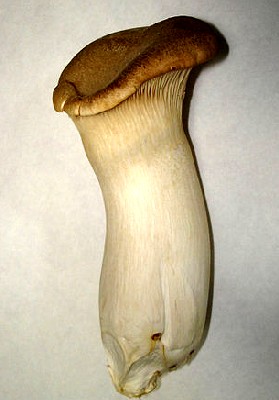
Photo: Wiki User Liquid-s
King Oyster Mushroom (Pleurotus eryngii)
Rad. Eryngii [king oyster mushroom root], Rad. Aconri very [root of Epidendrum dendrobii], Rad. Aristolochiæ longæ root of birthwort], Rad. Gentianæ [root of Gentiana], Phu [Valerian root], Cortic. Radic. Mandragotæ [peeled root of Mandrake], Sem. Ligustici [Ligusticum seeds], Sem. Rutæ [Rue seeds], Sem. Sinoni, seu Amomi vulgaris Officinarum [seeds of common amomum], Sem. Carui [caraway seeds], Sem Amomi veri [true amomum seeds], Sem. Petroselini Macedonici [seeds of Macedonia Parsley], Sem. Ammeos [seeds of bishop’s weed], Sem. Dauci Cretici [seeds of Cretan Carrot], Anacardii præparti [prepared cashews] , Baccarum Lauri [Bayberries], Piperis longi [long pepper], Piperis Albi [white pepper], Rosarum rubearum [red roses], Thymi [thyme], Pulegii [Pennyroyal], Chamadryos [Germander], Ligni Aloes [Aloe], Xylobalsami [balsam wood], Castorei [Castor], Opopanacis [Opopanax], Mastiches [mastic], Sulphuris vivi [true sulfur], Margaritarum albarum [white pearls], Blattæ Byzantiæ [onyx], Offis de corde Ceryi ana drachm semis [heart of stag, mix half dram], grana tria [3 grains], Fol. Auri numbero viginti quinque [gold leaf, number 25], Fol. Argenti number duodecim [silver leaf, number 12], Limaturæ Eboris [ivory filings], Calami aromatici vulgaris [common aromatic quill], Pyrethri ana grana novem [Chrysanthemum, 9 grains]; Mellis triplum [three times as much honey], id est, circiter libras dua [that is, about two pounds]."2
Description: "Aurea Alexandrina is effectuall against the cold defluxions [flows - running nose and such] of the head: good for weeping eyes, the tooth ach, consumption [tuberculosis], collicke, cough, and spitting of bloud: and profitteth the paine in the reynes [kidneys], and intermitting fevers [usually malarial fevers]. But the cause why I have not appointed this good composition, nor any of the three last mentioned Philontums to the Surgeons Chest, though I know them to be good medicines, is because they will not keepe an East India voyage, and Laudanum opiate paracelsi is sufficient for ought the other can doe. Wherefore I rest satisfied therewith."3
1 John Woodall, the surgions mate, 1617, p. 87; 2 Johann Zwelfer, Pharmacopoeia Augustana reformata, p. 449; 3 Woodall, p. 87-8;
Confectio Alkermes
Listed in: Woodall-Chest: Confectio Alkermis1, Moyle: Spec. Conf. Alcherm.2, Tweedy: Conf. Alkerm.3Category: Compound - Electuaries
Photo: Gerhard Eisner
Kermes Berries -
Phytolacca Americana
Rx: "Of the Juyce of fragrant Apples, of the best Damask Rosewater, of each {1.5 pounds} infuse in them for the space of a whole day, the husks or Cods of Silk-worms (Serioum Crudem) {1 pound} make a strong expression; to which adde the best Juyce of Kermes-berries {1 pound} Sugar {2 pounds} boyl them till they come almost to the body or consistence of Honey; to which, whilst hot added crude Amber small cut {2 drams} and when 'tis dissolved, cast in these Powders, of Cinamon, Aloes-wood, of each {6 drams} the Azure-stone burnt and washed, Pearl, of each {2 drams} Leaf Gold {1 dram} Mosch {1 scruple} make thereof a soft Electuary."4
Description: "Confectio Alkermes preserveth from Apoplexies [unconsciousness caused by hemorrhage or stroke] arising from cold, and melancholy humors [yellow bile, one of the bodily humors], doth very much comfort the braine, and heart, and is sometimes used very profitably for them that languish away through long sicknesse and are subject to swoundings [fainting]."5
Apothecary John Quincy dismisses this confection, explaining that it "is greatly in use amongst the Female Prescribers, and when it is met with any where else, it seems more in compliance to them, than out of any great opinion of its Virtues. It makes indeed a pretty Decoration in a Julep, from the Leaf-Gold in it; and sometimes raises the Spirits by Expectation [the placebo effect], because it is generally taken for a high Cordial: but instead of {2 scruples} which is seldom exceeded in a Dose, if a Person was to take a whole Ounce, he would not find it to do any great matters that way."6
1 John Woodall, the surgions mate, 1617, p. 84; 2 John Moyle, The Sea Chirurgeon, 1693, p. 31; 3 "158. John Tweedy's Bill for Medicines. November 8, 1743". Privateering and Piracy in the Colonial Period Illustrative Documents, John Franklin Jameson, ed., p. 460; 4 Jean de Renou, A Medicinal Dispensatory, 1657, p. 616; 5 Woodall, p. 84; 8 John Quincy, Pharmacopoeia Officinalis & Extemporanea, 1722, p. 382
Confectio Hamech
Listed in: Woodall-Chest: Confect. Hamech1, Moyle: Confect. Hamech2
Category: Compound - Electuaries
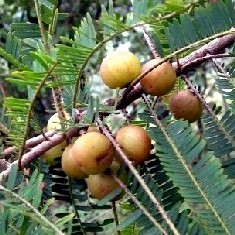
Photo: L. Shyamal
Mmyrobalan Emblica - Indian Gooseberry
Rx: "Bark [rind] of yellow Myrobalans, {2 ounces} black and chebul [yellow] ones, violets, pulp of coloquintida, polypody of the oak, of each {1-1/2 ounce} wormwood, thyme, of each {1/2 ounce} aniseeds, fennel-seeds, red-rose leaves, of each {3 drams} beat them, and steep them in six pints of whey one day, then boil them to three pints, and strain them, and to the liquor add juyce of fumitory, pulp of prunes, and raisins, of each {half-pound} white sugar, despumed [clarified] honey, of each {1 pound} boil them to thickness of honey; when it is almost boiled enough, sprinkle into it agarick trochiscat, sennæ powdered, of each {2 ounces} rubarb powdered, {1-1/2 ounce} epithymum, {1 ounce}, diagridium [scammony], {6 drams} cinnamon, {1/2 ounce} ginger {2 drams} seed of fumitory, and anise, spikenard, of each {1 dram} make them into an Electuary according to art."3
Description: "Confectio Hamech purgeth choler [black bile, a bodily humor], melancholy [yellow bile, another bodily humor], and salt phlegme [phlegm is a bodily humor, salt is one of Paracelsus' primary principles], and is therefore with great benefit used against diseases arising form the same, the Canker [cancer], Leprosie, or drie Scurfe, Madnesse, Ringworme, Manginesse, scabbes and the like: the dose is {6 drams}."4
1 John Woodall, the surgions mate, 1617, p. 82; 2 John Moyle, The Sea Chirurgeon, 1693, p. 31; 4 Thomas Brugis, The Marrow of Physick, 1669, p. 107-8; 4 Woodall, p. 82-3
Confectio Hyacinth
Listed in: Moyle: Spec. Conf. de Hyacinthis1
Category: Compound - Electuaries
Photo: Gerhard Eisner
Kermes Berries -
Phytolacca Americana
Rx: "Take of Jacinth, red Coral, Bole armenick, Earth of Lemnos, of each half an ounce; the berries of Cherms [Kermes], the roots of Tormentil and Dittany [dittany of Crete - Origanum dictamnus], the seeds of Citrons, Sorrel and Purslain, Saffron, Myrrh, red Roses exungulated [pared off - probably having the petals removed from the flower and used], all the sorts of Sanders [Sandalwood – probably white, yellow and red], bone of a Stags heart, Harts horn, Ivory prepared, of each four scruples, Saphire, Emerald, Topes [topaz], Pearls, raw silk, leaves of Gold and Silver, of each two scruples: Camphire, Musk, Ambergreese [ambergris], or each five grains; with Syrup of Lemons, make it into a confection according to Art."2
Description: "It is a great Cordial [good medicine for the heart] and cool, exceeding good in acute Fevers and Pestilence. It mightily strengthens and cherisheth the Heart. Never above half a dram is given at a time, very seldom so much; because of its offensiveness, but I suppose its chargeableness [cost?]."3
John Quincy warns that syrup of lemons will cause the other ingredients to fement, so he suggests leaving it out, noting the confections "is best preserv'd in dry Form; because any moisture by degrees supplies and softens those Rigiditeies, in which their Astringency [cleansing ability] consisted." He goes on to say it "is much prescrib'd in Diarrhæa's and Vomitings, and is a very good Medicine for such Purposes. Dose {10 grains to 1/2 dram}."4
1 John Moyle, The Sea Chirurgeon, 1693, p. 35; 2,3 Nicholas Culpeper, Pharmacopœia Londinesis, 1720, p. 161; 4 John Quincy, Pharmacopoeia Officinalis & Extemporanea, 1719, p. 383
Diaprunum Lentivum
Listed in: Woodall: Diaprunum Simplex1
Category: Compound - Electuaries
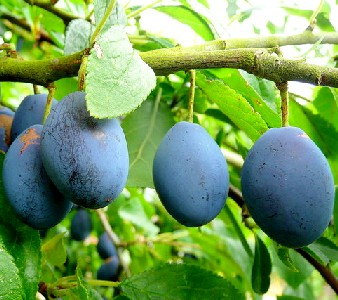
Photo: Jonathan Billenger - Damson Plum Used for Damascus Prunes
Rx: "'Take of new and ripe Damascus Prunes one hundred; boil them in a sufficient Quantity of Water till they are soft; then remove them from the Fire, and when cold drive the Pulp through a Sieve, and set by for use. In the Liquor [liquid] strained from the Prunes before pulping boil {1 ounce} of Violet Flowers, and after straining again, dissolve it in {2 pounds} of Sugar, and boil into a Syrup; to which add of the forementioned Pulp {half pound} of Cassia and Tamarinds dissolved in a little of the same Decoction, and pulped, {mix 1 ounce} Boil them over a gentle Heat, and frequently stir the Mixture; after which sift in the following Powders, of Coriander Seed, Rhubarb, Liquorice, and Marshmallow Roots, {mix} a sufficient Quantity to make into a soft Electuary."2
Description: "Diaprunum simplex is commended for a gentle laxative, not only against continuall and hot intermitting fevers, but also against all hot diseases, and against the vices of the lungs, throte, reines [kidneys], and bladder, the dose is {1 ounce}."3
1 John Woodall, the surgions mate, 1617, p. 82; 2 John Quincy, Pharmacopoeia Officinalis & Extemporanea, 1722, p. 439; 3 Woodall, p. 82
Electuarium Cariocostinum
Listed in: Moyle: Electuarium Cariocostinum1
Category: Compound - Electuaries
Humoral Property: Hot2
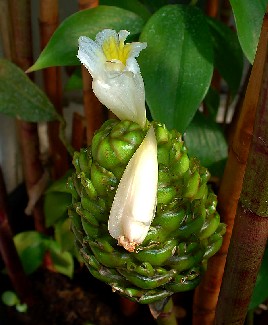
Photo: H. Zell - White Costus (Costus Pictus)
Rx: "'Take of Cloves, white Costus or Zedoary [tumeric], Ginger, and Cummin Seeds {of each 2 drams} of Hermodactyls cleared of their Husks, and of Diagrydium [scammony], {of each 1/2 ounce} of the Honey of Roses three times the quantity of the whole: Let them all be powdered together besides the Diagrydium, and stirred into the Honey of Roses with a wooden Spatula; and at last put in the Diagrydium powdered by it self, and make into an Electuary, S. A. [according to art]."3
Description: "[Johann] Zwelfer gives this a great Commendation for purging away Choler [yellow bile, one of the bodily humors], and breaking away the Obstruction of the cachetick Constitutions [those who waste away from illness]: And it is an excellent Purge for strong People. It works very briskly, and fetches the Humours from the most remote Parts; and is therefore found of great service in Rheumatisms, and arthritick Complaints. It's Warmth also, and Fitness to carry off watry cold Humours, makes it very good in Dropsies [edemas], and such like gross Habits. In Apoplectick [unconsciousness caused by hemorrhage or stroke] and Paralytick Cases likewise, where the Fibres want to be stimulated and shook with briskness, this is a proper Medicine if purging be required; but this is too smart [sharp] for weakly People. Its Dose from {1 dram to 6 drams}."4
1 John Moyle, The Sea Chirurgeon, 1693, p. 31; 2,3,4 John Quincy, Pharmacopoeia Officinalis & Extemporanea, 1722, p. 422
Electuarium Catholicon/Diacatholicon
Listed in: Woodall-Chest: Electuarium Diacathelicon1 Moyle: Electuarium Catholicon2, Tweedy: Catholicon3
Category: Compound - Electuaries
Humoral Property: "cooling"3
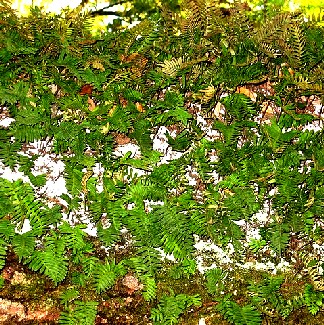
Photo: Wiki User DanielCD
Pleopeltis Polypodioides Growing On Oak Tree Limb
Rx: "'Take Polypody of the Oak {3 ounces}. sweet Fennel-Seeds {6 drams}. boil in a sufficient quantity of Water to {2 pints}. To the strain'd Liquor [liquid] put Sugar {2 pounds}. and boil to the Consistence of a thick Syrup, to which add Sena in Powder {2 ounces}. Violets, Aniseeds, Penydates [penidiarum - hazelnuts with sugar], Sugar-Candy, Liquorice, and of the four greater cold Seeds [Citrullus (Watermelon), Curcubita (Squash), Cucumber, and Melon (muskmelon)], {of each w drams}. Pulps of Cassia and Tamarands, {of each 2 ounces} and stir them all together."4
Description: "This is used as a gentle Lenitive [laxative], but wears much out of practice, and is now seldom order'd. Its Dose is from {2 drams to 1 ounce}. The two Drams of cold Seeds, Sugar-Candy, &c. make a very simple part of the Medicine, and are as well left out."5
"It is a fine cooling purge for any part of the Body, and very gentle; it may be given (an ounce or half an ounce at a time, according to the strength of the Patient) in acute and per acute [very acute] diseases, for it gently loosneth the belly, and adds strength: it helps infirmities of the Liver and Spleen, and Gouts of all sorts, Quotidian [occuring daily], Tertian [occuring every other day] and Quartan [occuring every three days] Agues [malarial fevers], as also Head aches. It is usually given in Clysters. If you list [desire] to take it inwardly, you may take and ounce at night 'going to Bed, in the morning drink a draught of hot posset drink [posset drinks were cream-based, often with sugars, ales or wines and other flavor enhancers like cinnamon or ginger and rose-water. They were believed to be good for curing the ill.], and go about your business."6
1 John Moyle, The Sea Chirurgeon, 1693, p. 31; 2 "158. John Tweedy's Bill for Medicines. November 8, 1743". Privateering and Piracy in the Colonial Period Illustrative Documents, John Franklin Jameson, ed., p. 459; 2 Nicholas Culpeper, Pharmacopœia Londinesis, 1720, p. 171; 4,5 John Quincy, Pharmacopoeia Officinalis & Extemporanea, 1719, p. 402; 6 Culpeper, p. 17
Electuarium de Ovo (Electuary of Eggs)
Listed in: Woodall-Chest: Electuarium de ovo.1
Category: Compound - Electuaries
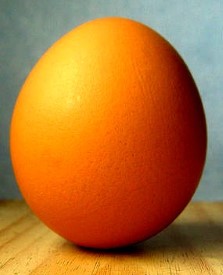
Photo: Kacper Anioleck - An Egg
Rx: "Take a Hens Egg new laid and the white being taken out by a small hole, fill up the void place with Saffron, leaving the yolk in; then the hole being stopped ro[a]st it in ashes till the shell begin to look black, take diligent heed the Saffron burn not for then is the whole Medicine spoilt, the matter being taken out, dry it so that it may be beaten into powder, and add to it as
much powder of white Mustard seed as it weighs. Then take the Roots of white Dittany and Tormentil, of each two drams; Myrrh, Hartshorn, Petatisis [Butterbur] Roots, of each one dram; the Roots of Angelica and Burnet, Juniper berries, Zedoary [tumeric], Camphire [Camphora], of each half an ounce, mix them all together in a Mortar, then add Venice Treacle the weight of them all, stir them about with a Pestle 3 hours together, putting is so much Syrup of Limmons as enough to make it into an Electuary according to Art."2
Description: "Electuarium de ovo is very much commended for prevention and cure of the plague, and all pestilentiall diseases in expelling the infection from the heart."3
"A dram of it given at a time, is as great a help in a Pestilential Fever, as a man shall usually read of in a Galenist [according to Galen's theory of medicine]. It provokes sweat and then you shall be taught to use it your self. If years [the age of the patient - too young or old] do no not permit, give not so much."4
John Quincy calls it "an admirable Alexipharmick [medicine for treating poisoning]; and by the help of the Camphire, much better than the Venice-Treacle or Mithridate: but for what reason we well know not, it is almost fallen into disues, and hardly ever prescrib'd or made. Its Dose from {1 scruple to 2 drams}.'"5
1 John Woodall, the surgions mate, 1617, p. 84; 2 Nicholas Culpeper, Pharmacopœia Londinesis, 1720, p. 165-6; 3 Woodall, p. 84; 4 Culpeper, p. 166; 5 John Quincy, Pharmacopoeia Officinalis & Extemporanea, 1719, p. 407
Electuarium de Succo Rosarum
Listed in: Woodall: Electuarium de succo Rosarum1
Category: Compound - Electuaries
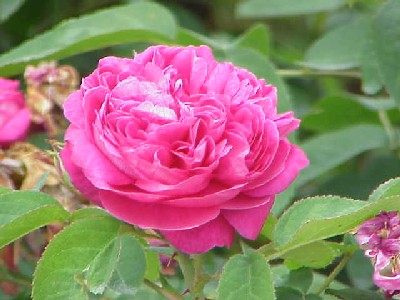
Photo: Kurt Stuber - Damask Rose
Rx: "'Take of Sugar, and the Juice of Damask Roses, {mix 1 pound} {4 ounces} of three kinds of Sanders [Sandalwood – probably white, yellow and red], {mix 1/2 ounce} of Mastich {3 drams} of Diagrydium [scammony] {12 drams}. Let the Sanders be reduced to a fine Powder, and mixed with the Diagrydium and Mastich, after they have been separately powdered; and then mixed with the Juice of Roses and Sugar, boiled up into a Syrup, while it is warm, so as to make them together into an Electuary.'"2
Description: "The Electuarie of the juice of Roses is powerfull in purging of yellow choler [yellow bile, one of the bodily humors]: the dose is {1 ounce}"3. Thomas Brugis says that it also purges phlegm, another of the bodily humors.4
1 John Woodall, the surgions mate, 1617, p. 83; 2 John Quincy, Pharmacopoeia Officinalis & Extemporanea, 1722, p. 441; 3 Woodall, p. 83; 4 Thomas Brugis, The Marrow of Physick, 1669, p. 107
Electuarium Diaphenicon
Listed in: Woodall-Chest: Electuarium Diaphenicon1
Category: Compound - Electuaries
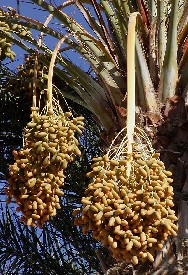
Dates on a Date Palm
Rx:"Take of the pulp of Dates boyled in Hydromel [mead], Penids [penidiarum - hazelnuts with sugar], of each half a pound: sweet Almonds blanched three ounce and an half; to all of them being bruised and permixid [mixed], add clarified honey two pound, boyl them a little, and then strew in Ginger, long Pepper, Mace and Cinnamon, Rue leaves, the seeds of Fennel and Carrots, of each two drams; Turbith [Operculina turpethum] beaten small 4 ounces, Diagridium [scammony] an ounce and half: make of them an Electuary according to Art."2
Description: "Diaphenicon purgeth easily, and safely flegme and melancholy [phlegm and melancholy - bodily humors]: it helpeth the belly ake, collicke, continuall burning fevers, and all evills proceeding of choler and flegme [choler & phlegm - bodily humors]: the dose is {1 ounce}."3
"This comes pretty much up to the Virtues of Caryocostinum, and is a good Drastick Purge, tho now almost disused. Dose from {1 dram to 1/2 ounce}."4
1 John Woodall, the surgions mate, 1617, p. 82; 2 Nicholas Culpeper, Pharmacopœia Londinesis, 1720, p. 170; 3 Woodall, p. 82; 4 John Quincy, Pharmacopoeia Officinalis & Extemporanea, 1719, p. 403

